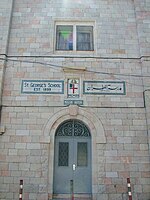Mandelbaum Gate
1949 establishments in Israel1949 establishments in Jordan1967 disestablishmentsBorder crossings of divided citiesBuildings and structures demolished in 1967 ... and 4 more
Buildings and structures in JerusalemCheckpointsGatesIsrael–Jordan border crossings

The Mandelbaum Gate is a former checkpoint between the Israeli and Jordanian sectors of Jerusalem, just north of the western edge of the Old City along the Green Line. The first checkpoint for the Hashemite Kingdom of Jordan/Israel Mixed Armistice Commission at the Mandelbaum Gate, from the close of the 1948 Arab–Israeli War in 1949 until August 1952, was moved from the Israeli side of the Gate to the Demilitarised Zone after the "Barrel Incident". The second checkpoint existed until the 1967 Six-Day War. The Gate became a symbol of the divided status of the city.
Excerpt from the Wikipedia article Mandelbaum Gate (License: CC BY-SA 3.0, Authors, Images).Mandelbaum Gate
Haim Bar-Lev, Jerusalem Bab a-Zahara
Geographical coordinates (GPS) Address Nearby Places Show on map
Geographical coordinates (GPS)
| Latitude | Longitude |
|---|---|
| N 31.787483333333 ° | E 35.226813888889 ° |
Address
חיים ברלב
Haim Bar-Lev
9511208 Jerusalem, Bab a-Zahara
Jerusalem District, Israel
Open on Google Maps








